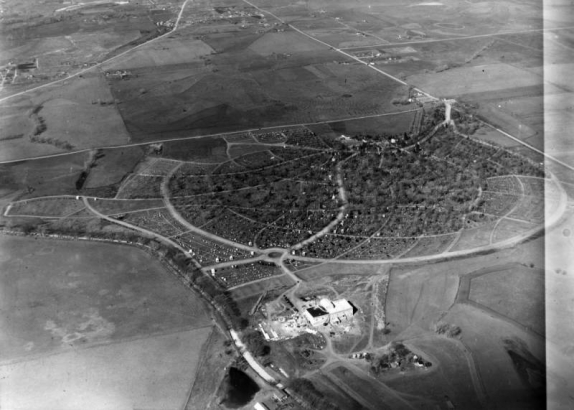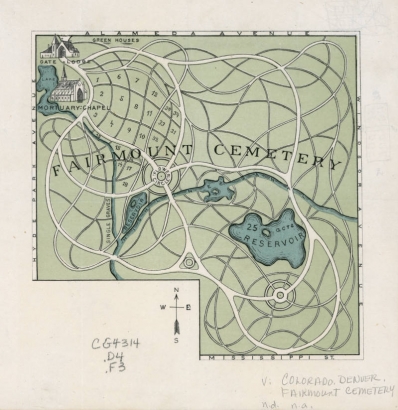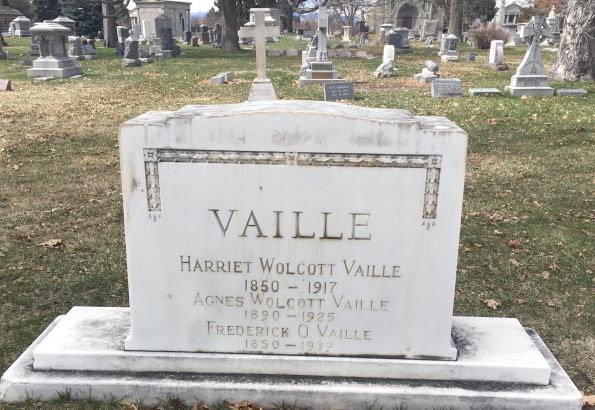The historical Fairmount Cemetery in Denver is a lovely place to pursue recreation and peace, at any time, but particularly during a pandemic. While this may seem like a morbid pastime to some Americans, many world cultures make regular pilgrimages, celebrations, and even picnics at cemeteries. Such activities also would not have been unusual to Americans in centuries past, and, during our current situation, the leisurely cemetery stroll is a lovely old-fashioned hobby to revisit. Offering beautiful landscape design, vast acreage, and solitude, graveyards are an ideal place to spend time outdoors. And with 130 years of Denver history, Fairmount Cemetery is one of the most enjoyable and educational to visit.
Fairmount Cemetery was designed by landscape architect Reinhard Schuetze, who was also responsible for Washington and Cheesman Parks, and sections of City Park. In 1890, the cemetery opened its gates at Alameda Avenue and Oak Street (now Quebec). The new location was an alluring alternative to Riverside Cemetery, established in 1876. Riverside was located in the area now known as Commerce City, and increasingly was experiencing railroad and industrial activity at its borders. Fairmount Cemetery also picked up the mantle of the City Cemetery, which closed that year in preparation to become current-day Congress and Cheesman Parks. Fairmount Cemetery was launched as a pastoral park out on the plains near Windsor Farm, for Denver’s well-heeled and regular folks alike.
While Fairmount Cemetery today is firmly nestled among residential and commercial development, at its inception it was a bit of a trek from populous city life. This fact didn’t keep it from its role in outdoor recreation: the burial ground even had its own railroad for three years, beginning in 1893!
The rail line's northern terminus at Center Avenue and Oak Street (today’s 8th Avenue and Quebec) connected with the rest of the city via the Colfax Electric Railway route. The Fairmount line then ran in a southerly direction for a mile and a half, eventually delivering perambulation-seeking passengers right at the cemetery's front gates. As it’s unlikely that families would be running their dearly departed to the graveside on a street car, the existence of a cemetery train gives some indicator of the volume of casual traffic.
Our modern Fairmount Cemetery is a giant park totaling 280 acres, with rolling grass rises, 78 varieties of trees, dirt paths, marble mausoleums, and even the gurgling Highline Canal passing through. The cemetery’s size makes social distancing a cinch; quietly buzzing bees are more frequent than living humans. But perhaps most enjoyable of all to the student of history: wandering through the park one discovers the graves of old friends (and sometimes foes).
Strolling through the cemetery, you will encounter the formerly powerful or historically significant, as well as everymen of every sort. There are former Coloradans who helped build early institutions and public works, and bestowed their names on streets and towns: John Evans, John Iliff, William Byers, and William Loveland among them. There are also graves marking history’s darker chapters: Colonel John Chivington and John Galen Locke among them.
Particularly sobering in this moment is the small memorial standing alone in an otherwise empty field, dedicated to the victims of the 1918-1919 Spanish Flu epidemic.
Cemetery visitors can choose to wander aimlessly and allow providence to lead them to these surprises, or for the more organized souls, there are published walking guides. The Western History & Genealogy collection holds just such a guide covering the oldest inner loop of the cemetery, published by former Colorado State Historian David Halaas in 1980. Following the route outlined by Halaas in the image below will take you past many of the luminaries and scoundrels of our local history.
Agnes Wolcott Vaille, 1890-1925
Secretary of the Denver Chamber of Commerce, WWI Red Cross volunteer, and active early Colorado Mountain Club member who loved climbing and the outdoors. Ms. Vaille was the unfortunate soul who froze to death in 1925 during the first successful winter summit of Longs Peak.
John Elitch, 1852-1891 and Mary Elitch Long, 1856-1936
The Elitches turned their Denver Highlands farm into a magical public resort featuring music and entertainment, a zoo and botanical gardens, and eventually an amusement park.
William G. Fisher, 1844-1897
Half of the duo of proprietors who established Denver’s Daniels & Fisher department store in the 1870s. The store soon became the largest in the state. Although Fisher died before the enterprise expanded to fill an entire city block in 1911, his name continued to grace the successful store until its closure in 1958. Fisher’s name endures in the renowned Daniels & Fisher Tower at 16th and Arapahoe.
Reinhard Schuetze, 1860-1910
Those who have been reading closely will recognize this name. You will recall we can thank this landscape architect for Washington Park and Cheesman/Congress parks, early City Park Zoo gardens, and Fairmount itself. Schuetze formally trained in forestry and garden design in his native Germany, and applied his skill to creating unique and beautiful planted environments throughout Denver. He lived on the cemetery grounds until 1894. There’s something quite romantic that Schuetze’s largest project was also his place of eternal repose.
Elrey Borge Jeppesen, 1907-1996
A more recent burial, this gentleman gives “dead reckoning” a whole new meaning. Mr. Jeppesen was an early contributor to aviation history. His career ranged from barnstormer to airmail pilot, to businessman. Jeppesen invented the aeronautical maps used by pilots (similar in concept to road maps, these improved upon the formerly prevalent “dead reckoning” system, hence the tasteless pun above). The Denver International Airport has dedicated the airport’s main terminal to Mr. Jeppesen, including an exhibit on his life and work. The company he founded still produces maps today.
~~~~~~~~~~~~~~~~~~~~~~~~~~~~~~~~
We hope this brief glimpse into Fairmount Cemetery inspires you to find your own favorites. For those seeking nature in the city, and historical perspective in these troubling times, we encourage you to visit. To those already well-familiar with wandering the cemetery, I’ll see you out amongst the graves!
For additional resources related to Fairmount Cemetery, see the following:
- 125 Things to Do at Fairmount
- Denver Cemeteries Historical Background
- Fairmount Sexton’s Records, 1891-1953
- Walk Into Historic Colorado: A self-guided walking tour of Fairmount Cemetery
- Obituaries, Cemeteries, and the Dead
- Cheesman Park’s Past Life…As a Cemetery
- Denver Public Library Clipping files: Denver. Cemeteries. Fairmount
- Forgotten dreamer, Reinhard Schuetze : Denver's landscape architect / Don and Carolyn Etter







Comments
Thanks for this article! I
Thanks for this article! I ride my bike to Fairmount now and again, and during stay-at-home, much more often than usual. I go birding there, ride my bike or walk the paths looking at the interesting stones, but I have never gotten a walking guide, so I'm looking forward to my next visit!
Hello Laura (great name!).
Hello Laura (great name!). Let us know if you make any exciting discoveries! What birds have you seen there?
Thank you for your wonderful
Thank you for your wonderful article on Fairmont. I actually learned to drive there on the numerous small roads, and many relatives of mine, including my Parents, rest there. I particularly was interested in the biographical information on several well-known Denverites, especially Elrey Jeppesen.
Hello Ralph! Fairmont would
Hello Ralph! Fairmont would've presented some wonderful challenges to the early driver, with the curving, sometimes bumpy unpaved roads. It is also a lovely place to have family to visit. Thank you for reading.
This is an awesome article!
This is an awesome article! Thank you for the fascinating read. Do you happen to know if the Mausoleum is currently open to the public?
Hi Angelica. I'm glad you
Hi Angelica. I'm glad you enjoyed it! Thanks for your comment. I don't know for certain if it's open. When I last visited over a month ago now, they had a sign on the door listing hours it was open (and I had just missed them). You might try calling to confirm before you go.
Add new comment